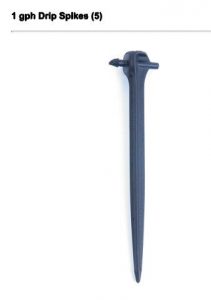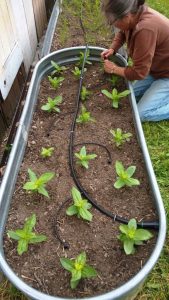Trial 1: “A” Bed
signage:
TRIAL 1: Tomatillos, Asparagus, Zinnias
Installed 05/18/2018Gravity-Fed Irrigation Kit with 1 gallon per hour drip spikes and 60 mesh screen filter washer (Lee Valley Tools)
PROS: Inexpensive, easy and fast to set up
CONS: Very slow, uneven water distribution, some spikes stopped working completely
We purchased a Gravity Feed Irrigation Kit from Lee Valley Tools for $43.50. Lee Valley Tools is located in Canada and they occasionally offer free shipping. The system is simple and can be set up in a few hours. We connected the elevated water barrel to a single line of “header hose” (1/2-inch solid tubing) and ran it across 3 adjacent raised garden beds that were already planted with asparagus crowns in the middle and zinnia and tomatillos transplants at both ends. There is a filter inside the fitting that connects the header hose to the hose that runs to the water barrel. The other end of the header hose is capped.
Gray Line: Hose that connects to elevated water barrel
Black Line: 1/2″ head hose (Solid Tubing)
Red Line: 1/4″ micro tubing (Solid)
Green Arrows: Spike Emitters
Emitters are used to release water slowly to the soil. The rate of flow may vary depending on the type of emitters used as well as other factors such as debris the clogging the hole or the filter. Emitters with a flow rate of one gallon per hour are recommended for use with a gravity-fed system. The first time we ran this system, all of the “drip spikes” (emitters) released water. Some of them released water more quickly than others so we modified them by attaching a small length of ¼-inch solid tubing to slow down the flow. See Lee Valley Tools Gravity Feed Watering Kit for more on this kit.
The second time we ran this system, a number of the drip spikes released no water. We made sure the water barrel was filled, checked the filter for clogging and straightened the header hose. We later attached “take apart emitters” from another trial and found that these worked while many of the drip spikes continued to fail. By that point, we gave up on this system and resorted to hand watering for the rest of the summer. We plan to reconfigure this system using take apart emitters and a better filter.
Fortunately, the majority of plants were asparagus crowns that grew deep roots quickly so did not require much water. The zinnias and tomatillos suffered from lack of water during the high temperatures in July but bounced back with regular watering 2-3 times per week depending on the weather. The tomatillos were not as productive as they might have been but the zinnias did well. Some of the first tomatillos displayed blossom end rot, a physiological disorder that often results from lack of calcium uptake due to insufficient water at critical times during fruit formation.



